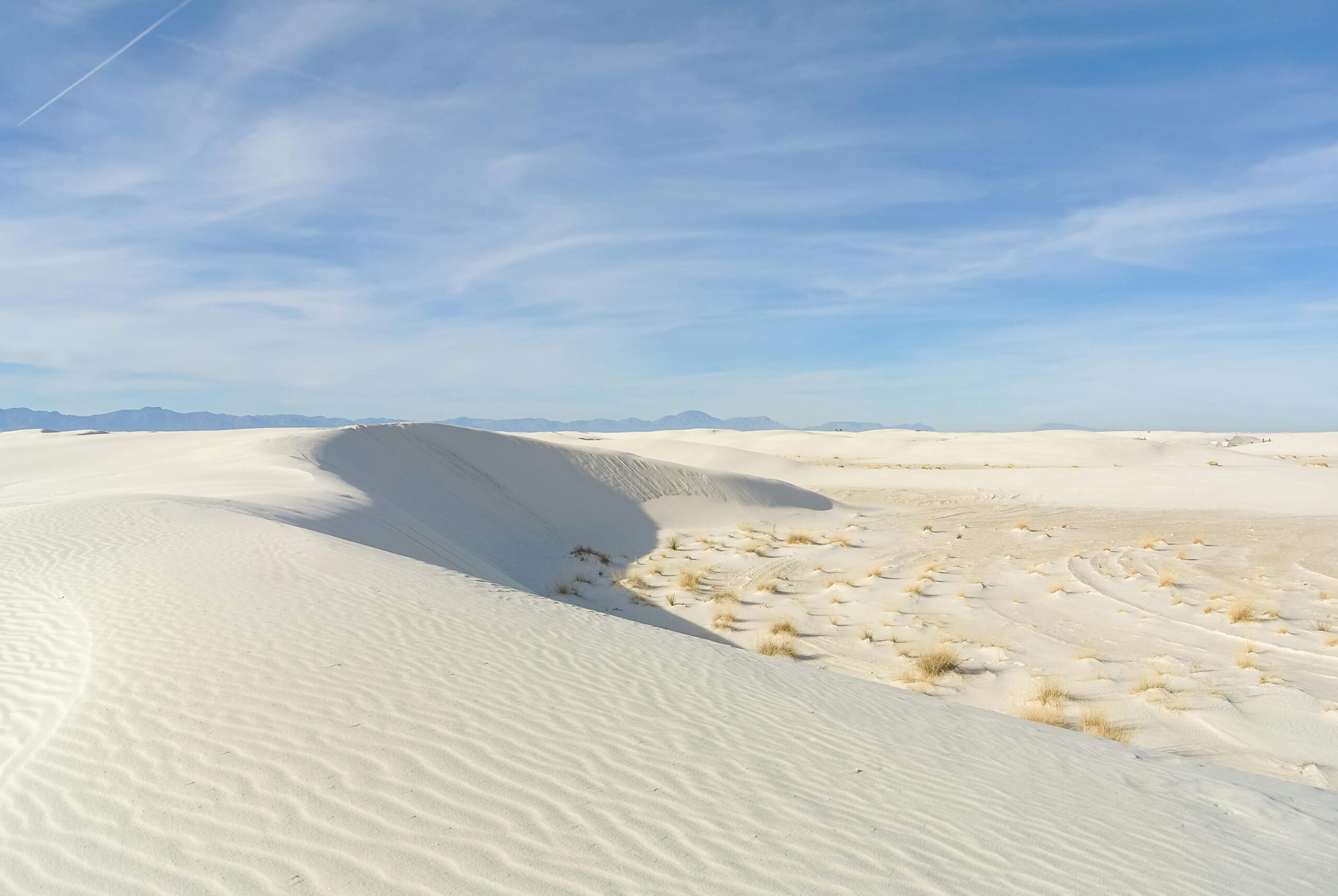Looking for a unique adventure? White Sands National Park is home to the largest gypsum dune field in the world. This blog will show you what makes this park special and how you can enjoy it.
Keep reading!
Key Takeaways
- White Sands National Park has the world’s largest gypsum dune field, located in New Mexico.
- The park is home to unique plants and animals that have adapted to live in a harsh desert environment.
- Visitors can enjoy activities like hiking, sledding on the dunes, and taking photos of the beautiful landscape.
- There are efforts to protect the park’s ecosystem through conservation measures and research.
- Best times to visit are during spring and fall for milder weather.
Geography and Geology of White Sands National Park
White Sands National Park covers a vast area of the Tularosa Basin in southcentral New Mexico. The park’s shimmering white sands, formed from gypsum dunes, create an otherworldly landscape that constantly shifts and evolves due to the dynamic movement of the dunes.
Location and size
White Sands National Park sits in the heart of the Tularosa Basin, which is a unique spot in southcentral New Mexico. This national park covers about 275 square miles of desert, making it one of the world’s largest gypsum dune fields.
The vast sea of glistening white sands offers an amazing view that stretches far and wide, seeming to merge with the sky at the horizon.
The area is not just big but also surrounded by mountains on three sides. These mountains help keep the gypsum sand trapped in this basin, creating huge dunes that can be seen for miles.
Visitors find themselves amidst towering waves of sand as they explore this waterless sea under the vast blue sky of the Chihuahuan Desert.
Formation of gypsum dunes
Gypsum dunes at White Sands National Park are unique. They come from gypsum, a soft mineral rarely found as sand because it dissolves in water. But here’s the trick: the Tularosa Basin, where the park sits, has no outlet to the sea.
So when rain falls, it carries gypsum from surrounding mountains into the basin’s low spots. Then, the water evaporates and leaves pure gypsum behind.
Over thousands of years, winds break down these crystals into fine grains that form the glistening white dunes we see today. These sands cover about 275 square miles of desert in southcentral New Mexico.
The process keeps going as new gypsum is washed down and dried out by evaporation. Now that we know how these amazing dunes are formed let’s look at how they move over time.
Dynamic movement of the dunes
The dunes at White Sands National Park are always on the move. They travel up to 30 feet a year, pushed by strong winds coming from the southwest. This movement keeps the landscape changing all the time.
It’s like a never-ending dance of sand across the Tularosa Basin.
Visitors see different shapes and sizes of dunes every time they come. Some dunes rise gently; others have steep slopes. Even though they’re moving, these huge gypsum dunes still create homes for plants and animals in this unique desert environment.
Climate and Weather
White Sands National Park experiences diverse weather patterns throughout the year, with scorching summers and mild winters. Visitors can expect hot temperatures in the summer, making early mornings or late afternoons ideal for exploring the park comfortably.
Seasonal variations
White Sands National Park experiences extreme temperature variations throughout the year. Summers are scorching, with temperatures soaring above 100°F during the day. Winters, on the other hand, can be quite chilly, with nighttime temperatures dropping below freezing.
The park is open year-round for visitors to explore and enjoy outdoor activities. However, it’s essential to be prepared for the weather conditions when visiting.
During summer months, it’s crucial to carry plenty of water and wear sunscreen and a hat to shield yourself from intense sun exposure. In winter, warm layers are necessary to stay comfortable in the desert chill.
Spring and fall offer milder temperatures and are generally considered ideal times to visit due to more moderate weather conditions for hiking or enjoying other recreational activities amidst the glistening white sands.
Best times to visit
The best times to visit White Sands National Park are during the spring and fall. You should avoid visiting during the summer as temperatures can soar above 100°F.
- Spring (March to May): Mild temperatures make this a pleasant time for outdoor activities like hiking and biking.
- Fall (September to November): The weather is cooler, and it’s an excellent time to explore the park without extreme heat.
- Winter (December to February): Despite colder temperatures, winter also offers unique experiences, but be prepared for chilly conditions.
Plan your visit to White Sands National Park during spring or fall to make the most of your outdoor adventures in this mesmerizing gypsum dune field.
Flora and Fauna
White Sands National Park is home to a variety of unique plant species and native wildlife, adding to the park’s diverse ecosystem. Visitors can immerse themselves in the desert environment while observing the fascinating flora and fauna that have adapted to thrive in this arid landscape.
Unique plant species
White Sands National Park is home to a diverse array of plant life. Despite the harsh desert environment, several unique plant species have adapted to thrive in this otherworldly landscape.
Visitors can witness the resilient Soaptree Yucca, with its tall stalk and cluster of sword-like leaves, adding a touch of green to the glistening white sands. The park also hosts rare flora such as the White Sand Verbena and Sand Spurry, which bloom in delicate shades against the stark gypsum fields.
The Chihuahuan Desert surrounding White Sands National Park boasts an impressive number of endemic plants – those found nowhere else on Earth. These remarkable adaptations showcase nature’s ability to flourish under extreme conditions while providing a captivating sight for nature enthusiasts and botany aficionados alike.
Native wildlife
The unique desert environment of White Sands National Park is home to a variety of native wildlife adapted to survive in this harsh landscape. You may spot some creatures like the kit fox, antelope ground squirrel, and several lizard species scurrying about on the gypsum dunes.
Additionally, over 600 species of invertebrates have been identified within the park, including beetles and spiders that have developed strategies for thriving in this arid setting.
It’s important to admire these animals from a respectful distance as they go about their daily activities.
White Sands National Park provides a great opportunity for visitors interested in observing desert wildlife in its natural habitat. As you explore the park’s trails or enjoy other outdoor activities, keep an eye out for these fascinating creatures that call White Sands home.
Activities for Visitors
Discover the exhilarating hiking trails cutting through the glistening white sands, offering a breathtaking experience of the unique desert environment. Feel the thrill of sledding down huge dunes or capturing stunning photography opportunities in this mesmerizing landscape.
Hiking trails
White Sands National Park offers visitors a variety of stunning hiking trails to explore. The park’s unique gypsum dunes provide a one-of-a-kind backdrop for outdoor exploration. Here are some of the top hiking trails to check out:
- Interdune Boardwalk Trail: This easy, paved trail takes you through the heart of the dunes, offering fantastic views and the opportunity to learn about the unique desert ecosystem.
- Dune Life Nature Trail: A short loop trail that provides insights into the plant and animal life that have adapted to this harsh environment. Look out for lizard tracks and other signs of wildlife along the way.
- Alkali Flat Trail: For those seeking a more challenging trek, this 5-mile trail leads hikers across the stark beauty of the Alkali Flat, showcasing the expansive dune field and panoramic views of the surrounding mountains.
- Backcountry Camping Trail: Adventure seekers can obtain permits to explore designated camping areas within the park’s backcountry, providing an unparalleled experience under the starry desert sky.
Exploring these trails allows visitors to immerse themselves in the breathtaking beauty and natural wonders of White Sands National Park, making for an unforgettable outdoor adventure amidst glistening white sands and stunning desert landscapes.
Sledding on the dunes
Sledding on the dunes offers an exhilarating experience on the glistening white sands. Visitors can rent sand sleds at the park’s gift shop, ensuring fun for all ages.
- Sand sled rentals available at the park’s gift shop.
- Sledding down the dunes provides an exciting adventure.
- Suitable for visitors of all ages.
- Enjoy the unique sensation of sliding on gypsum sands.
This thrilling activity promises unforgettable memories amidst the stunning desert landscape of White Sands National Park. After sledding, visitors can explore other engaging activities within the park.
Photography opportunities
White Sands National Park offers mesmerizing photography opportunities amidst its glistening white sands and unique desert landscape. Here are some photo-worthy moments you can capture during your visit:
- Sunrise and Sunset: Capture the breathtaking hues as the sun rises or sets over the expansive gypsum dune field.
- Play of Light and Shadows: Experiment with the interplay of light and shadows on the undulating dunes, creating captivating contrasts.
- Desert Flora and Fauna: Frame shots of the resilient plant life and wildlife that thrive in this seemingly harsh environment.
- Sledding Activities: Take action shots of friends or family sledding down the pristine sandy slopes for dynamic, fun-filled images.
- Panoramic Views: Utilize panoramic shots to encompass the vastness of the gypsum fields against a backdrop of clear blue skies.
These photographic opportunities at White Sands National Park promise to capture unforgettable moments in a mesmerizing desert setting.
Nearby Attractions
Explore the ancient petroglyphs at the Three Rivers Petroglyph Site, marvel at space history at the New Mexico Museum of Space History, and venture into the impressive underground world of Carlsbad Caverns.
Discover more!
Three Rivers Petroglyph Site
The Three Rivers Petroglyph Site is a remarkable archaeological site in southern New Mexico. It houses over 21,000 petroglyphs, some dating back over a thousand years. These ancient rock carvings showcase diverse designs and symbols that offer a glimpse into the daily lives and beliefs of the early inhabitants of the region.
The site features trails for visitors to explore while enjoying close-up views of these intriguing petroglyphs amidst the stunning desert landscape.
Visitors can experience around 5 miles of hiking trails where they can view these captivating petroglyphs up close. It’s an excellent opportunity to witness ancient history and immerse oneself in the rich cultural heritage of this area.
Moreover, located just about an hour drive from White Sands National Park, it makes for a fascinating addition to your itinerary when visiting this part of Southcentral New Mexico.
New Mexico Museum of Space History
Discover the wonders of space exploration at the New Mexico Museum of Space History. Located in Alamogordo, it offers a fascinating journey through the history and future of space travel.
Visitors can explore captivating exhibits featuring artifacts from space missions, learn about the science behind space exploration, and even experience what it’s like to be an astronaut with interactive displays.
This museum also boasts an impressive collection of rockets, satellites, and spacecraft that have played pivotal roles in advancing our understanding of outer space. From the early days of rocketry to modern-day innovations, this museum provides a comprehensive look at humanity’s quest to unlock the mysteries beyond our planet.
With its engaging displays and educational programs, the New Mexico Museum of Space History is a must-see destination for anyone intrigued by the cosmos.
Carlsbad Caverns
After exploring the wonders of the New Mexico Museum of Space History, venture to Carlsbad Caverns, a fascinating underground world located in the Chihuahuan Desert. These caverns are known for their immense size and incredible limestone formations, with over 119 caves formed from ancient seas.
The most famous cave is the Big Room, which spans 8.2 acres — making it one of the largest underground chambers in North America. Visitors can explore this enchanting realm by walking down into its depths or taking an elevator that descends 750 feet.
The Carlsbad Caverns are home to some of the oldest speleothem formations on Earth, such as stalactites and stalagmites dating back as far as 250 million years ago. Every evening from late spring through early fall, hundreds of thousands of Mexican free-tailed bats swirl out of the cave entrance at sunset during their nightly feeding frenzy – a remarkable natural spectacle not to be missed.
Conservation and Preservation Efforts
White Sands National Park is dedicated to protecting the unique gypsum dune field and its delicate ecosystem. Ongoing efforts focus on preserving this remarkable natural wonder for future generations to enjoy.
Protecting the gypsum dunes
To protect the unique gypsum dunes, White Sands National Park has set up conservation measures. This includes managing visitor activities to prevent damage to the delicate ecosystem and reduce human impact on the dunes.
Ecological research is also conducted to understand the flora and fauna in this environment, providing valuable insights for preservation efforts. The park collaborates with scientific institutions to ensure that these striking natural formations remain sustainable for future generations.
Preserving the gypsum dunes at White Sands National Park is vital for maintaining this stunning desert landscape’s natural beauty. By implementing strict conservation measures and conducting important ecological research, the park aims to safeguard this extraordinary environment now and for years to come.
Ecological research
Ecological research at White Sands National Park plays a crucial role in understanding and preserving the unique desert environment. Scientists study the diverse plant species, like the Soaptree Yucca and sand verbena, to learn how they thrive in this harsh landscape.
They also monitor native wildlife such as kit foxes, roadrunners, and burrowing owls to ensure their habitats are protected.
Furthermore, ongoing research examines the impact of human activity on this delicate ecosystem. This includes tracking changes in vegetation cover and dune movement due to visitor foot traffic.
By gathering this vital data, park officials can implement measures to safeguard the park’s natural beauty for future generations.
Visitor Tips
When visiting White Sands National Park, make sure to bring plenty of water and sunscreen. Stay on designated trails and follow safety guidelines while enjoying the beautiful gypsum dunes.
What to bring
When planning a visit to White Sands National Park, here’s what you should bring:
- Sunscreen to protect your skin from the intense desert sun.
- Plenty of water to stay hydrated, as the park’s climate can be very dry and hot.
- Comfortable walking shoes for exploring the gypsum dunes and hiking trails.
- Sunglasses to shield your eyes from the bright sunlight reflecting off the white sands.
- A camera or smartphone for capturing the stunning natural beauty and unique scenery.
Safety precautions
Before visiting White Sands National Park, it’s important to be aware of the safety precautions to ensure a safe and enjoyable experience:
- Stay hydrated: The desert environment can lead to rapid dehydration, so make sure to bring an ample supply of water for your visit.
- Protect yourself from the sun: Wear sunscreen, a hat, and sunglasses to avoid sunburn and heat-related issues.
- Dress appropriately: Wear comfortable, breathable clothing and sturdy footwear suitable for walking on sand dunes.
- Be cautious when sledding: While sledding on the dunes is a popular activity, it’s essential to choose designated areas and use proper equipment to avoid accidents or injuries.
- Observe wildlife from a distance: Respect the natural habitat of the park’s wildlife by keeping a safe distance and refraining from feeding or approaching animals.
- Follow park regulations: Familiarize yourself with park rules and guidelines, including designated trails, restricted areas, and camping regulations.
Remember that respecting the park’s natural environment and being mindful of safety measures will contribute to a positive experience for all visitors.
Conclusion
In the heart of Southcentral New Mexico lies the stunning White Sands National Park, where glistening white sands stretch as far as the eye can see. This unique natural wonder offers a wide array of outdoor activities, from hiking and sledding on the dunes to capturing breathtaking photography opportunities.
Visitors can immerse themselves in the beauty of this desert landscape while appreciating ongoing efforts to conserve and protect this extraordinary environment. Whether you’re an outdoor enthusiast or simply seeking natural beauty, White Sands National Park is a must-visit destination for anyone exploring the Southwest United States.
FAQs
1. What is White Sands National Park?
White Sands National Park is a beautiful area in New Mexico, famous for its stunning white sand dunes, which are made of gypsum. The park offers amazing views and unique landscapes that attract many visitors each year.
2. What activities can I do at White Sands National Park?
You can enjoy various activities at White Sands, like hiking on trails, sledding down the dunes, and taking photos of the breathtaking scenery. There are also ranger-led programs to learn more about this special place.
3. When is the best time to visit White Sands National Park?
The best time to visit is during spring or fall when temperatures are mild and comfortable for outdoor fun. Summer can be very hot, while winter may bring cooler weather but still has its charm with fewer crowds.
4. Do I need a permit to enter White Sands National Park?
Yes! You need an entrance pass to explore the park. You can buy it online or at the entrance station when you arrive; this helps support park maintenance and conservation efforts.







Leave a Reply